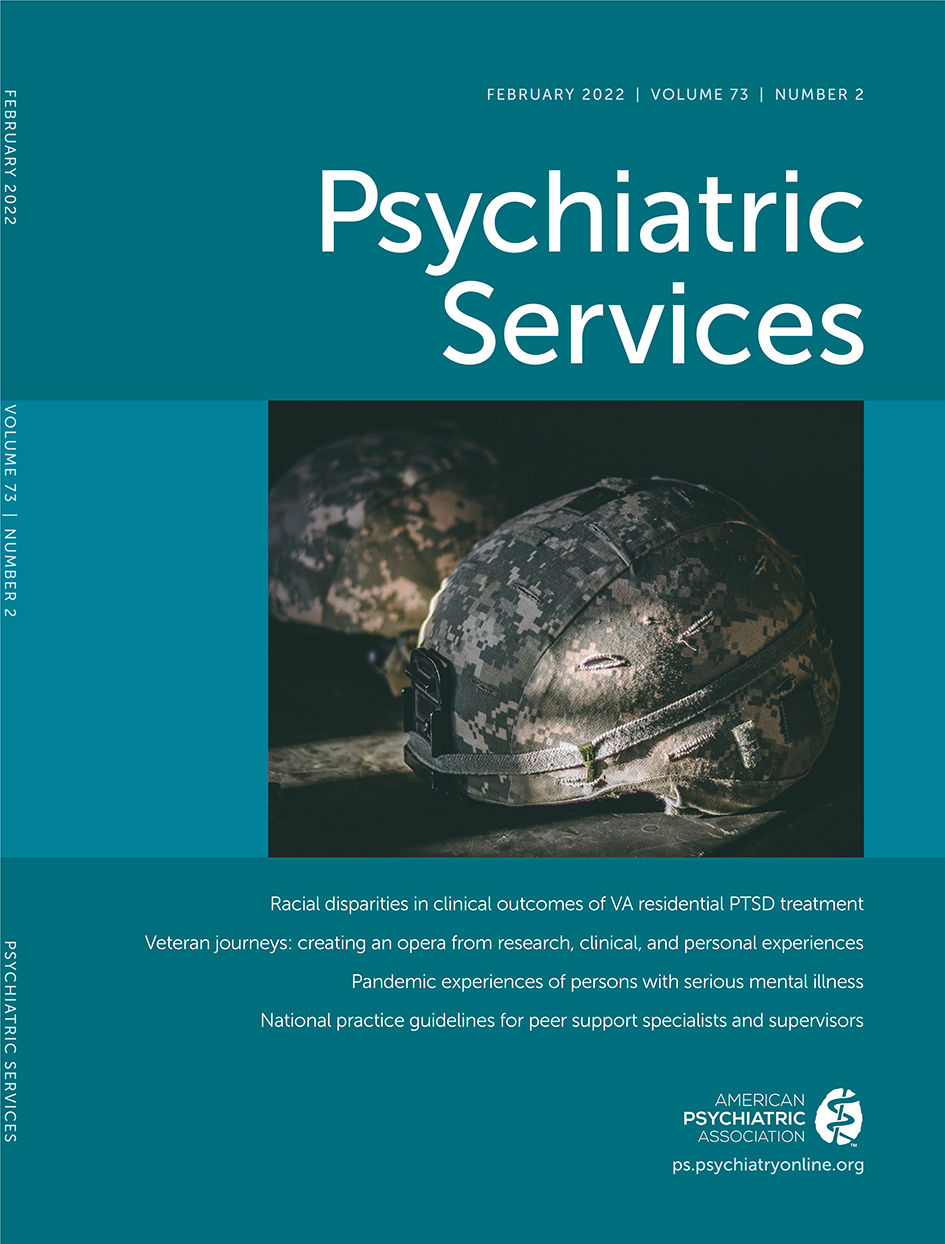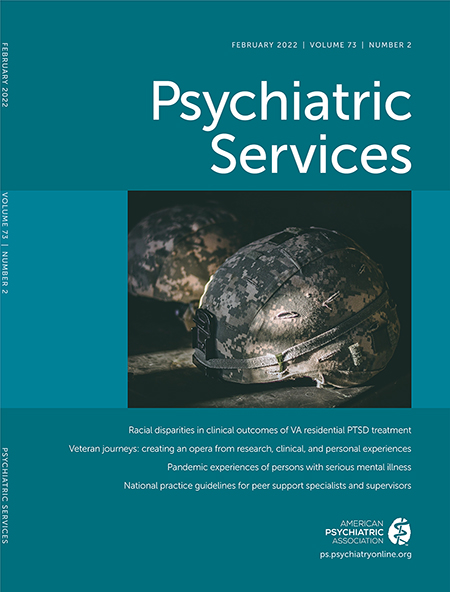Peer support workers are individuals with lived experience of a mental health or substance use condition who are trained, and in many cases certified by their state, to provide peer support services (
1,
2). The peer support profession has grown and evolved across the world as evidence indicating their effectiveness in clinical settings has increased (
3–
5). In the United States, this growth has been largely facilitated by peer support services being reimbursed through Medicaid, the largest U.S. payer of mental health services (
6). Nearly all states, the District of Columbia, and the U.S. Department of Veterans Affairs now certify peer support providers (
7). A 2016 research effort identified 25,317 certified peer specialists in the United States (
8).
With this expansion and movement into clinical settings, the need for peer-informed supervision practices has become increasingly apparent. Supervision is an essential component in any human service organization, and effective supervision is associated with job satisfaction, retention rates, and consumer experience (
2–
4,
9,
10). To support alignment with best practices in peer support services, the National Association of Peer Supporters (N.A.P.S.) recently developed supervision guidelines that can be adopted by supervisors within organizations to help strengthen supervisors’ skills and maintain the integrity of peer support. These guidelines are intended to illustrate how supervisors can integrate peer support values into supervision practice. In this column, we provide an overview of the need for guidelines for supervisors, review the process of their development, and explore the use and feasibility of these guidelines within practice settings.
Establishing Core Values
N.A.P.S. is the professional association for the peer support workforce in the United States. A nonprofit membership association founded in 2004, N.A.P.S. aims to grow the peer support profession by promoting inclusion of peer specialists in health care and community systems. Since 2006, N.A.P.S. has supported its members through training programs and regular communication; moreover, it has held the only annual conference in the United States devoted specifically to the peer support workforce and its allies.
In 2013, after inclusive development and consensus-building processes, N.A.P.S. issued the National Practice Guidelines for Peer Supporters (NPG) (
11). The NPG described 12 core values of peer support and included examples of the values in practice (
Table 1).
Through a consensus process, the association achieved 98% agreement among 1,000 peer support specialists across the United States. Although developed and verified in the United States, this guidance has also helped to further define peer support practice internationally. Notably, the NPG are included in the World Health Organization QualityRights guidance to peer support workers in respecting and protecting the rights of people with mental health disabilities (
12). Since 2013, the NPG have provided peer support specialists with a framework to educate, advocate, and maintain the core values of peer support.
The Supervisor’s Role
In 2017, N.A.P.S. leadership became increasingly aware of concerns within the peer support workforce community about supervision practices contradicting or conflicting with core peer support values. Peer support specialists were frequently assigned menial tasks unrelated to direct peer support practice, which focuses on voluntary engagement, instilling hope, disclosing strategically, and creating opportunities for constructive dialogue and meaningful activities that facilitate recovery and goal fulfillment. Because the peer support worker role and approaches are unfamiliar to many supervisors, peer specialists often found themselves in situations where they were minimized, stigmatized, marginalized, undermined, exploited, and retraumatized. In some cases, peer support workers experienced moral injury when directed to perform a job task that would cause to others the same harm the peer supporters had previously experienced as service users.
To respond to these concerns, a work group composed of seven nationally recognized N.A.P.S. members and board members (six of whom were current or former peer support specialists or supervisors) was convened and met regularly over 18 months. The work group first sought to determine what guidance existed on the supervision of peer support workers. Although the supervision of peer support workers by a mental health professional had been an established requirement for Medicaid funding for more than a decade, “the empirical literature offered little guidance to address the purpose, content, or process of supervision of the non-clinical peer support worker role” (
9). Some of the research literature offered supervision as an avenue toward role clarity but without specific guidance on supervision based on recovery-oriented practices or on the values of peer support. After a review of both empirical and gray literature, the work group determined a gap existed in supervision specific to the peer support workforce. Any relevant public domain information was categorized by the work group and made publicly available on the N.A.P.S. website in a repository of supervision resources (
https://www.peersupportworks.org/resources/supervision-resources).
Next, the work group drafted practical tips and guidance on the role of the supervisor to strengthen, integrate, and uphold peer support values. This revision to the NPG became known as the National Practice Guidelines for Peer Specialists and Supervisors (NPG-S) (
13). The NPG-S followed a development and consensus process similar to the original NPG (
11).
The work group reviewed the 12 core values from the existing NPG. Each new guideline focused on ways in which supervisors could help peer specialists uphold the core values and practices of peer support.
During the development of the NPG-S, work group members used their real-world experiences in receiving supervision, in supervising peer support staff, or both. After the first draft was written, N.A.P.S. members were invited to complete targeted surveys to refine the supervision guidelines. The work group incorporated feedback received from 151 peer support specialists and 109 supervisors.
The work group then arranged four online feedback sessions to determine how supervisors and peer support specialists might use the guidelines. Twenty of the 44 invited N.A.P.S. members participated in a feedback session. The work group analyzed notes from the feedback sessions, incorporated suggestions on content changes, and noted recommendations for future projects. A final draft was then circulated to the peer support workforce via e-mail through the N.A.P.S. listserv and affiliated peer organizations. In 2013, it was relatively easy to solicit feedback from 1,000 working peer specialists regarding the original NPG. However, the work group faced challenges identifying a large number of supervisors when soliciting feedback for the NPG-S. The N.A.P.S. membership and mailing lists for affiliated organizations are targeted to the interests of people with lived experience, which many supervisors may not consider to be relevant. Further efforts to locate and engage supervisors in ongoing education remain a priority for N.A.P.S.
The results of the consensus process showed that 91% of respondents (N=213 of 234 responses) endorsed the NPG-S. On the basis of the approval rating and positive responses to the questions, the work group determined that the original intent of the NPG-S, to provide guidance on the role of supervisors in supporting peer specialists in practicing the core values as outlined in the NPG, had been achieved.
In October 2019, N.A.P.S. and the supervision work group finalized the NPG-S, launched the guidelines at the N.A.P.S. annual conference in San Diego and posted them on the N.A.P.S. website (
13). After further dissemination of the NPG-S through webinars and learning communities, it became evident that these guidelines apply to all supervisors, whether or not they had experienced a personal journey of recovery from mental health or substance use or had previously worked as a peer support specialist.
Feedback and Future Uses
Participants in educational workshops and webinars about the NPG-S indicated that the guidelines were “straightforward and helpful” and could be used to help supervisors “better understand how the boundaries and ethics of peer support differ from those observed in clinical practice.” The guidelines can be used as a tool by supervisors to gauge their understanding of peer support practices and by peer support staff to provide feedback to their supervisor to improve the supervision experience. Participants in many of these settings have also suggested that the NPG-S could be used as a fidelity tool for peer support specialists to reflect on how well their own performance aligns in practice with the principles of peer support. These guidelines could also be used to increase management and executive leadership awareness of peer support and as an advocacy tool for increased application and implementation of peer support values in organizational culture.
The NPG-S provide additional opportunities to increase interdisciplinary team members’ understanding of the peer role and core peer support values in practice. Clinical supervisors may struggle to understand the equally challenging complexities of the nonclinical peer support role. Role clarity is a predictor of job satisfaction for peer support workers (
9,
10). As the peer support workforce has grown, noticeable increases in role confusion and role drift have occurred. These issues are far more likely to occur when a supervisor unfamiliar with the core values of peer support attempts to act as a mentor or role model for these values and peer support competencies (
9). For example, strategic or judicious self-disclosure is frequently outside a licensed practitioner’s professional scope of practice; yet licensed practitioners are the most frequent supervisors for the peer support workforce in traditional service settings. Standard clinical approaches to providing supervision are therefore antithetical to peer support values when the supervisor’s opportunities to effectively model peer roles are restricted.
Perhaps most importantly, the NPG-S can assist supervisors in realigning peer support specialists’ job descriptions and duties to match the underlying core value of mutual support, such as sharing relevant lived experience and reciprocal interpersonal relationships to build hope and trust, to foster identification, and to support choice. The NPG-S contain practical tips and new ideas for supervisors to consider when the supervisor’s own professional training or code of ethics limits or prohibits them from being able to model how to draw on their own personal recovery experiences with individuals whom they support.
Purpose
The main purpose of the NPG-S is to narrow the divide between supervisors and peer support specialists as they embark together on a mutual learning process about peer support values and how best to put them into practice. The NPG-S are not intended to address administrative or organizational supervision tasks, organizational development, or basic functions of supervision. Rather, they are designed to facilitate understanding, application, and support of peer support values in practice—the practice of engaging, connecting, and encouraging growth and recovery among those whom supervisors are privileged to support.
Future Directions
N.A.P.S. and the supervision work group continue to hold focus groups and develop training, technical assistance, and interactive tools based on members’ recommendations. A supervision self-reflection tool, which includes companion feedback that might typically be offered by those receiving supervision, is currently being developed. N.A.P.S. is committed to ensuring that supervisors will continue to play a critical role in the further development of these and future resources to ensure collaboration, understanding, continued mutual learning, and cross-pollination among all those engaged at any level within the peer support workforce.

